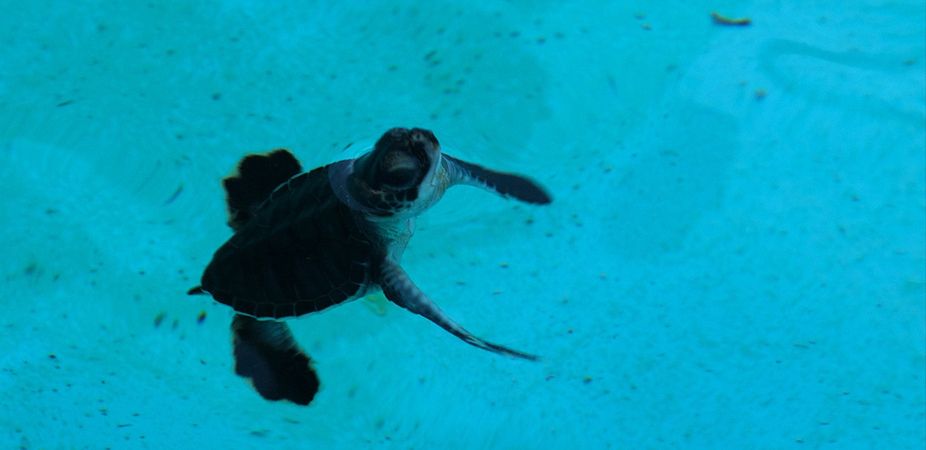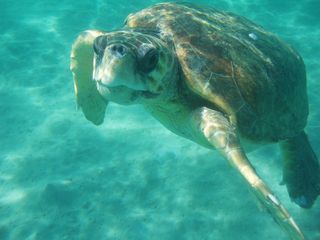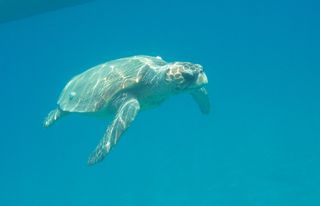
What Does Climate Change Mean for Sea Turtles? (Op-Ed)

This article was originally published at The Conversation. The publication contributed the article to Live Science's Expert Voices: Op-Ed & Insights.
You might have seen in recent news that climate change may increase the size of some sea turtle populations, by increasing the number of female turtles.
These studies hinge on an unusual trait of sea turtles: their sex is determined by the temperature in the nest. Turtle eggs incubated above 29C produce mostly females, while temperatures under 29C produce mostly males.
Our recent study published in Nature Climate Change found that by altering the sex ratio of turtle populations in favour of females, climate change could lead to a population increase in the short term. But this isn’t the whole story.
Warmer eggs make more females
The study found that rising temperatures might alter sex ratios and increase the size of some sea turtle populations.
Sea turtles are unusual in that the sex of hatchlings is determined, not by sex chromosomes (as is the case in humans and other mammals), but by incubation temperature, a phenomenon known as temperature-dependent sex determination.
Above a certain pivotal incubation temperature of 29C, the majority of sea turtle eggs produce female hatchlings, and vice versa. This pivotal temperature holds broadly for all sea turtle species and has presumably evolved to produce optimally balanced sex ratios.
Sign up for the Live Science daily newsletter now
Get the world’s most fascinating discoveries delivered straight to your inbox.
So warming temperatures may cause the feminisation of sea turtle populations through the production of only female hatchlings. Previous studies have highlighted how, all else being equal, this feminisation effect might lead to population extinctions.
However, while this threat of feminisation of sea turtle populations has been known for many years, there had previously been few attempts to predict how the sex ratio of populations may change in the future, and the resulting extinction risk.

The study, undertaken by an international team including scientists from Deakin University in Warrnambool (Australia) and Swansea University (UK) took place in one of the world’s largest sea turtle rookeries, the Cape Verde Islands in the Atlantic, where large numbers of loggerhead turtles breed. It recorded sand temperatures on nesting beaches over several years using small data-loggers.
These sand records were then combined with past measurements of environmental conditions on these islands since 1850, and climate predictions for the next 100 years made by the Intergovernmental Panel on Climate Change (IPCC). In this way a robust two hundred and fifty year time-series of incubation temperatures, hatchling sex ratios, and adult breeding sex ratios were derived.
The research found that increased temperatures would lead to increased feminisation of the species, but entire feminisation would not be imminent in the next few decades. In fact, warm incubation temperatures may have a short-term conservation benefit on the turtles, increasing the number of breeding females and hence the total size of the population
Climate change still bad for turtles
However, the study is not complete. There is much more work to be done to understand how sea turtles will be affected by climate change.
The study focused on one site in the Atlantic. There is a need to extend the study to further examine the threat of feminisation for sea turtles at their many other nesting sites around the world, including around the coast of Australia which is home to key populations of several species.
By extending these analysis methods, we can objectively identify those areas where climate change and feminisation of populations are likely to be most acute. In this way we can have an early warning for where future management intervention may be required, for example, in the form a shading nests to ensure that males are produced.

Further, as the number of males decreases, they are going to become ever more important and yet we know very little about them. Unlike females, male sea turtles do not come ashore and so are hard to study. While thousands of adult female turtles have been equipped with satellite tags, only a handful of adult males have been tracked.
There is an important knowledge gap here. We have started to address this gap by catching male turtles at sea and equipping them with satellite tags. In this way we have collected data giving an indication that males may breed more frequently than females. This finding suggests that skewed female hatchling sex ratios will actually translate to more balanced sex ratios of breeding males and females. More studies of breeding intervals need to be undertaken across different species and in different breeding locations.
So while the recent research provides some useful insights into how climate might impact sea turtles, a host of questions remain. The long-term prognosis for sea turtles in a warming world is not necessarily good.
Graeme Hays receives funding from Deakin University and Swansea University. He works for Deakin University and Swansea University.
This article was originally published on The Conversation. Read the original article. Follow all of the Expert Voices issues and debates — and become part of the discussion — on Facebook, Twitter and Google +. The views expressed are those of the author and do not necessarily reflect the views of the publisher. This version of the article was originally published on Live Science.













